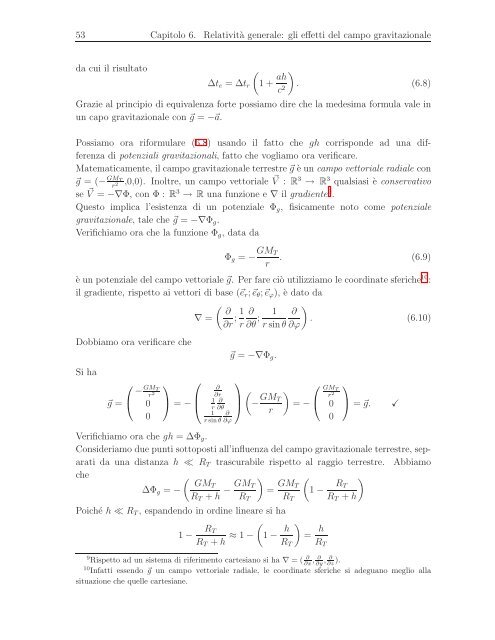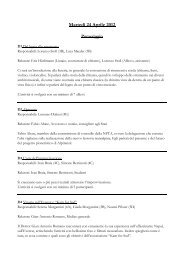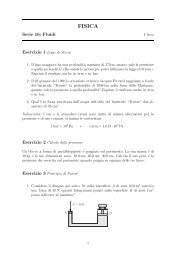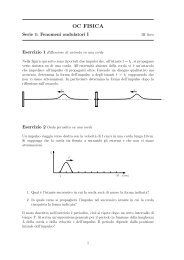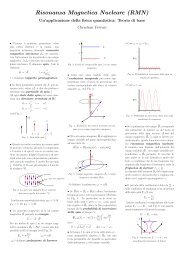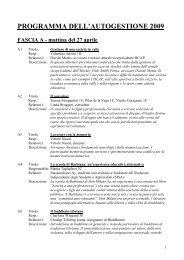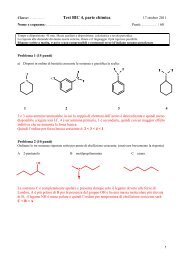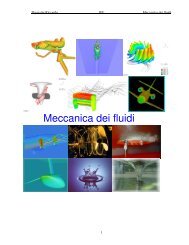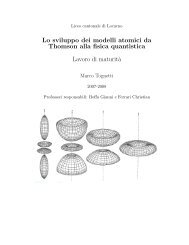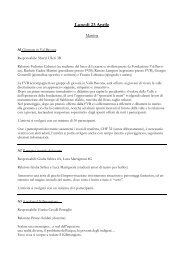Global Positioning System Lavoro di maturit`a - Liceo cantonale di ...
Global Positioning System Lavoro di maturit`a - Liceo cantonale di ...
Global Positioning System Lavoro di maturit`a - Liceo cantonale di ...
You also want an ePaper? Increase the reach of your titles
YUMPU automatically turns print PDFs into web optimized ePapers that Google loves.
53 Capitolo 6. Relatività generale: gli effetti del campo gravitazionale<br />
da cui il risultato<br />
∆te = ∆tr<br />
<br />
1 + ah<br />
c2 <br />
. (6.8)<br />
Grazie al principio <strong>di</strong> equivalenza forte possiamo <strong>di</strong>re che la medesima formula vale in<br />
un capo gravitazionale con g = −a.<br />
Possiamo ora riformulare (6.8) usando il fatto che gh corrisponde ad una <strong>di</strong>fferenza<br />
<strong>di</strong> potenziali gravitazionali, fatto che vogliamo ora verificare.<br />
Matematicamente, il campo gravitazionale terrestre g è un campo vettoriale ra<strong>di</strong>ale con<br />
g = (− GMT<br />
r2 ,0,0). Inoltre, un campo vettoriale V : R3 → R3 qualsiasi è conservativo<br />
se V = −∇Φ, con Φ : R3 → R una funzione e ∇ il gra<strong>di</strong>ente9 .<br />
Questo implica l’esistenza <strong>di</strong> un potenziale Φg, fisicamente noto come potenziale<br />
gravitazionale, tale che g = −∇Φg.<br />
Verifichiamo ora che la funzione Φg, data da<br />
Φg = − GMT<br />
r<br />
. (6.9)<br />
è un potenziale del campo vettoriale g. Per fare ciò utilizziamo le coor<strong>di</strong>nate sferiche10 :<br />
il gra<strong>di</strong>ente, rispetto ai vettori <strong>di</strong> base (er;eθ;eϕ), è dato da<br />
<br />
∂ 1 ∂<br />
∇ = ;<br />
∂r r ∂θ ;<br />
<br />
1 ∂<br />
. (6.10)<br />
r sin θ ∂ϕ<br />
Dobbiamo ora verificare che<br />
Si ha<br />
⎛<br />
g = ⎝<br />
− GMT<br />
r 2<br />
0<br />
0<br />
⎞<br />
⎛<br />
⎠ ⎜<br />
= −⎝<br />
∂<br />
∂r<br />
1 ∂<br />
r ∂θ<br />
1 ∂<br />
r sin θ ∂ϕ<br />
g = −∇Φg.<br />
⎞<br />
⎟<br />
⎠<br />
<br />
− GMT<br />
<br />
r<br />
⎛<br />
= −⎝<br />
GMT<br />
r 2<br />
0<br />
0<br />
⎞<br />
⎠ = g. <br />
Verifichiamo ora che gh = ∆Φg.<br />
Consideriamo due punti sottoposti all’influenza del campo gravitazionale terrestre, separati<br />
da una <strong>di</strong>stanza h ≪ RT trascurabile rispetto al raggio terrestre. Abbiamo<br />
che<br />
<br />
GMT GMT<br />
∆Φg = − − =<br />
RT + h RT<br />
GMT<br />
RT<br />
Poiché h ≪ RT, espandendo in or<strong>di</strong>ne lineare si ha<br />
1 − RT<br />
RT + h<br />
≈ 1 −<br />
<br />
1 − h<br />
RT<br />
<br />
<br />
1 − RT<br />
<br />
RT + h<br />
= h<br />
RT<br />
9 ∂ ∂ ∂<br />
Rispetto ad un sistema <strong>di</strong> riferimento cartesiano si ha ∇ = ( ∂x , ∂y , ∂z ).<br />
10Infatti essendo g un campo vettoriale ra<strong>di</strong>ale, le coor<strong>di</strong>nate sferiche si adeguano meglio alla<br />
situazione che quelle cartesiane.


